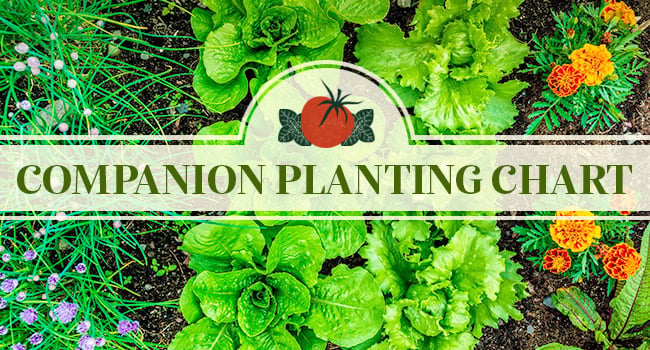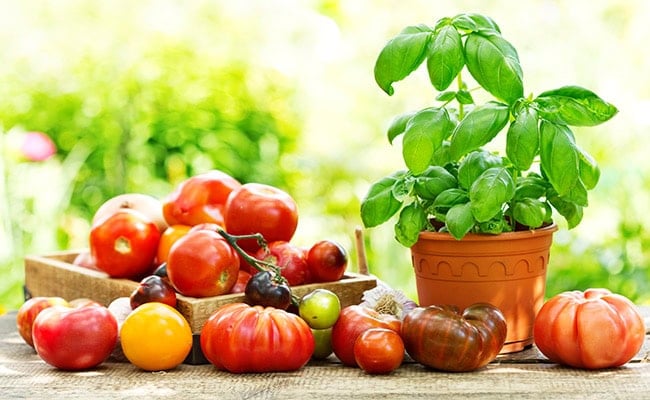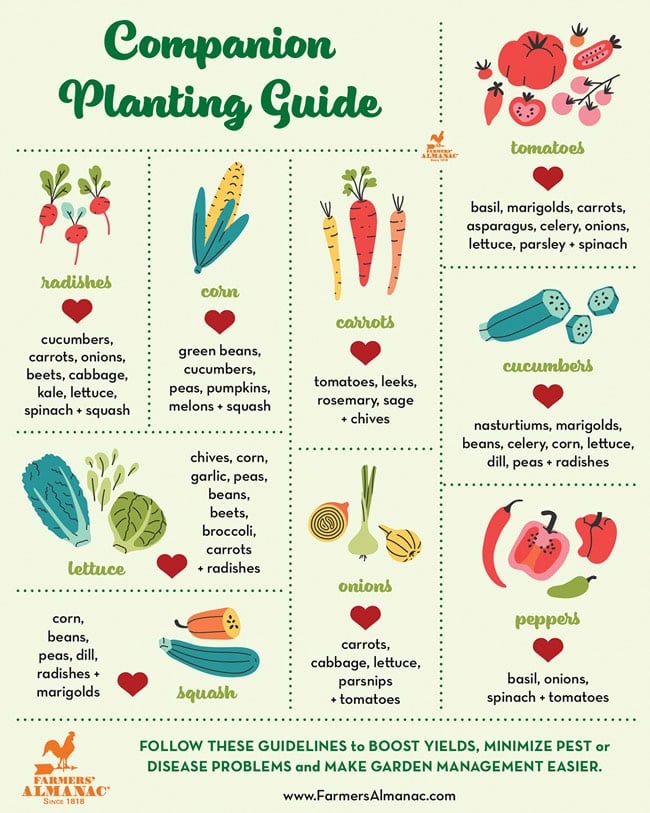How To Use Companion Planting Strategies To Maximize Your Home Garden Yield

For almost every vegetable you grow, there is likely to be a beneficial companion plant that will help increase soil nutrients, chase away pests, and help you get the most out of your garden. Companion planting is a great way to maximize the efficiency of your garden! Here is a list of the 17 most popular vegetables to grow along with their friends (and enemies). You may click on any of the names in the chart for growing information. Also, our Companion Planting Chart is followed by more information explaining why each pairing works well. Please share your questions and experience in the comments!
|
Companion Planting Chart
|
||
|---|---|---|
| Plant Name | Companion Plants ✅ | Do Not Plant Near ❌ |
| Asparagus | Tomato, basil | Onions, garlic, potatoes |
| Beets | Brassicas (broccoli, Brussels sprouts, cabbage), lettuce, kohlrabi, bush beans | Don’t plant beets near others of the same family (Beta vulgaris), including spinach and chard |
| Brassicas | Celery, beans, beets, dill, onions, lettuce | Tomatoes, eggplant, beans, peppers, squash |
| Brussels sprouts | See Brassicas | See Brassicas |
| Cabbage | See Brassicas | See Brassicas |
| Carrot | Tomatoes, leeks, rosemary, sage, chives | Coriander, dill, parsnips |
| Corn (sweet) | Beans, cucumbers, peas, pumpkins, melons, zucchini | Tomatoes |
| Cucumber | Marigolds, nasturtiums, beans, celery, corn, lettuce, dill, peas, radishes | Sage, rosemary, broccoli, cabbage, cauliflower |
| Green beans | Corn, beans, marigolds, nasturtiums, rosemary, summer savory, cucumbers, peas, potatoes, radishes, broccoli, Brussels sprouts, and other members of the cabbage family | Beets, onions (and anything from the onion family) |
| Lettuce | Mint, chives, garlic, marigolds, beets, broccoli, beans, carrots, corn, peas, radishes | Parsley, brassicas |
| Onion | Carrots, beets, cabbage, carrots, lettuce, parsnips, tomatoes, marjoram, savory, rosemary | Asparagus, beans, sage, peas |
| Peas | Beans, carrots, corn, cucumbers, radish, turnip, mint, chives | Garlic, onions |
| Peppers | Basil, onions, spinach, tomatoes | Beans, brassicas (such as broccoli, cauliflower, and cabbage), carrots, corn, cucumbers, radish, turnip, mint, chives |
| Potato | Beans, cabbage, peas, corn, marigolds, horseradish | Tomatoes |
| Radish | Cucumbers, carrots onions, beets, cabbage, kale, lettuce, spinach, squash | Hyssop, broccoli, cabbage, cauliflower, turnip, mustard. |
| Spinach | Lettuce, mustard greens, chard, kale, other leafy greens | Potatoes, corn, peppers |
| Squash (summer) | Beans, peas, radishes, peppermint, dill, parsley, oregano, marigolds | Potatoes, cucumbers, pumpkins |
| Squash (winter) | Corn, beans, sunflowers, marjoram, dill | Root crops like radishes, small plants |
| Tomato | Basil, marigolds, asparagus, carrots, celery, lettuce, parsley, spinach, onions (and others in the allium family such as shallots, leeks, garlic, etc.) | Cabbage, beets, peas, fennel, dill, rosemary, corn, potatoes |
| Turnip | See Brassicas | See Brassicas |
| Zucchini | See Squash (summer) | See Squash (summer) |
Companion Planting Details
Here is more information about each of the companion plants listed above, including reasons for why some plants are best (and worst) with others. Whereas the Companion Planting Chart above is in alphabetical order, the following is listed in order of popularity.
1. Tomato Companion Plants
The tomato, as we know it today, has come a long way from the time it grew wild in South America. Indigenous people cultivated them and slowly brought them north, experimenting with hybrids along the way. As a result, we have more than 10,000 kinds of tomatoes to enjoy today. It’s now one of the most popular vegetables in the United States—and a favorite for home gardeners to grow.
Friends: The best companion plants for tomatoes are also ones that complement them in recipes. Basil and tomatoes were made to go together, not only in sauces but in the garden, too. This herb helps tomatoes produce greater yields and it repels both flies and mosquitoes. Marigolds are another good companion, repelling nematodes and other garden pests. Other friends to tomatoes include asparagus, carrots, celery, the onion family, lettuce, parsley, and spinach.

Foes: Poor tomato companion plants include cabbage, beets, peas, fennel, dill, and rosemary. Corn and tomatoes both suffer from the corn earworm, and tomatoes and potatoes are affected by the same blight, so keep these plants separate to prevent the spread of pests or disease.
2. Companion Plants for Peppers
Although peppers were originally native to tropical areas, home gardeners can enjoy growing this vegetable throughout most of North America by purchasing transplants that have been started in greenhouses. and are particularly important in the cuisines of tropical Asia and equatorial America.
Friends: Excellent pepper companion plants include basil, which helps repel aphids, spider mites, mosquitoes, and flies and even potentially improves the pepper’s flavor. Other good companions include onions, spinach, and tomatoes.
Foes: Poor companion plants for peppers include pole beans as vines can get tangled among the pepper plants. Garden favorites from the brassica family, such as broccoli, cauliflower, and cabbage, are not good companion plants for peppers because they take similar nutrients from the soil and tend to attract pests such that may damage pepper plants.

3. Green Bean Companion Plants
Did you know the original green bean had primarily ornamental value? That’s because it took years to breed the natural stringy-ness out of green beans to make them more palatable for human consumption. Today, we enjoy hundreds of varieties of green beans—albeit, some of them are purple and red on the outside.
Friends: One of the best companion plants for green beans is corn because they make natural trellises, allowing beans to literally grow up with the corn. Beans also fix nitrogen in the soil, which is good for the corn. Marigolds, nasturtiums, rosemary, and summer savory repel bean beetles, and summer savory improves its growth rate and flavor. Other companions include broccoli, Brussels sprouts, and other members of the cabbage family along with cucumbers, peas, potatoes, and radishes.
Foes: Beets or anything from the onion family make poor green bean companions. Onions, in particular, impede the growth of bean plants.
Any questions? Contact [email protected]
4. Cucumber Companion Plants
Cucumbers, which are known for pickles, relish, and raw eating, originated in India where a great deal of genetic diversity exists. Over thousands of years, the cucumber has been cultivated throughout the world.
Friends: Excellent companion plants for cucumbers include marigolds and nasturtiums, which repel aphids and beetles. Beans, celery, corn, lettuce, dill, peas, and radishes are also good cucumber companion plants.
Foes: Aromatic herbs such as sage and rosemary make poor cucumber companion plants as they tend to stunt the growth of cucumbers. Broccoli, cabbage, and cauliflower can compete for similar soil nutrients.
5. Companion Plants for Onions
Although many people believe onions originated in central Asia, some research shows that onions may have been started in Iran and West Pakistan. Wild onions were likely used around the world for years before onions were formally planted and cultivated.
Friends: Carrots make good onion companion plants because onions will repel the carrot fly and chase away the aphids. Other good friends of onions include beets, cabbage, carrots, lettuce, parsnips (which also suffer from carrot fly), tomatoes, and spices like marjoram, savory, and rosemary.
Foes: Asparagus, beans, sage, and peas make more companion plants for onions. Onions may stunt their growth and negatively affect their flavor.
6. Lettuce Companion Plants
Interestingly, lettuce may have been cultivated by ancient Egyptians. However, it’s not clear that they ate the leaves as we do today, but instead may have used lettuce for oil production or as a religious sacrifice.
Friends: One of the best companion plants for lettuce is mint, which keeps away the slugs that feed on lettuce leaves. Chives and garlic help repel aphids, and marigolds attract aphid-eating ladybugs. Beets, broccoli, carrots, corn, peas, and radishes also work as good lettuce companion plants. And, finally, you may also want to plant a trellis of pole beans nearby as a wall of beans can provide shade as the weather grows warmer. Keeping lettuce plants cooler and well-watered can keep them from going to seed and becoming bitter.
Foes: Parsley, which tends to be bushy, can crowd your lettuce plants. Brassicas can compete with lettuces for the same nutrients.
7. Summer Squash or Zucchini Companion Plants
Zucchini may be known as one of the most prolific garden vegetables in our country. Some evidence exists that the first zucchini plants may have been grown 10,000 years ago as archeologists have discovered seeds in Mexican caves.
Friends: The best companion plants for zucchini are beans, peas, radishes, peppermint, dill, parsley, oregano and marigolds. Ideally, they should be grown with other plants that require regular watering but don’t require a great deal of space.
Foes: Potatoes make a poor zucchini companion plant, as both are prone to blight. Cucumbers and pumpkins should also be planted further away as they attract the same diseases and pests as zucchini.
8. Companion Plants for Carrots
Carrots are a staple vegetable for many gardeners, and the fact that they can be left in the ground during the winter makes them extra convenient.
Friends: Since carrots are heat sensitive, tomato plants that can provide them a bit of shade are excellent companions. Tomatoes are also known to produce solanine, which is a natural insecticide that targets pests affecting carrot plants. Since tomatoes benefit as well, they make perfect companion plants for carrots. Carrots aerate the soil around the roots of the tomato plants, allowing more air and water to reach the roots. Leeks and carrots are also good companion plants since leeks repel carrot flies and carrots repel leek moths and onion flies. Rosemary, sage, and chive also help repel carrot flies.
Foes: Both coriander and dill produce compounds that can harm carrot plants, and parsnips suffer from the same diseases and pests as carrots, so keep them apart to minimize a potential infestation.

9. Radish Companion Plants
Although radishes likely originated in Asia, they have probably been grown in western Europe since the mid-sixteenth century. Since they can be ready to eat in only four weeks, they are one of the fastest crops in a home garden.
Friends: Cucumbers make good companion plants for radishes as they distract cucumber beetles that like to feed on the radishes. They also do well among carrots because they are harvested before the carrots and they loosen the soil as the carrots start to take off. Onions, beets, cabbage, kale, lettuce, spinach, and squash are also good friends for radishes.
Foes: Hyssop makes a poor radish companion plant because it can inhibit growth. Since radishes belong to the brassica family, they may have a difficult time germinating near broccoli, cabbage, cauliflower, turnip, and mustard.
10. Companion Plants of Sweet Corn
A mutation in regular field corn, which led to the sweet corn that we know today, was originally discovered in Pennsylvania in the mid-1700s. Sweet corn is typically harvested before the corn is completely mature so we can enjoy the higher sugar content.
Friends: Corn loves veggies that fix nitrogen in the soil—like green beans. Cornstalks also make a great trellis for vining or trailing plants including beans, cucumbers, peas, pumpkins, and melons. Zucchini is a good sweet corn companion plant when planted among corn.
Foes: Tomatoes make poor companion plants of sweet corn, as both are attacked by corn earworms. Plant these two far apart to minimize the spread of these pests.
11. Potato Companion Plants
Potatoes are believed to have originated in the highlands of the Andes in western South America. In fact, researchers believe people started growing potatoes in that region as early as 8,000 to 5,000 BC.
Friends: Potato companion plants include beans, cabbage, peas, and corn. Marigolds planted near potato patches help deter beetles and horseradish will provide overall protection to potatoes.
Foes: Tomatoes as they are prone to blight, which can also affect potatoes, so they make poor companions for potatoes.
12. Companion Plants for Peas
Peas may have been one of the oldest cultivated crops with wild plants being native to the Mediterranean area. The oldest pea was 3,000 years old and found in Thailand.
Friends: Peas love to be planted by beans, carrots, corn, cucumbers, radish, and turnip. If you plant mint near peas, they should be healthier and tastier. Chives planted near peas also help deter aphids, making them excellent pea plant companions.
Foes: Don’t plant peas near garlic or onions as it will stunt their growth.
13. Companion Plants for Brassicas
Brassica vegetables include broccoli, cauliflower, and cabbage. Primitive varieties originated around the Horn of Africa (East Africa).
Friends: The best companion plants for broccoli and other brassicas include celery, beans, beets, dill, onions, and lettuce.
Foes: Try not to plant tomatoes, eggplant, beans, peppers, or squash nearby.
14. Asparagus Companion Plants
Asparagus are hearty and prolific in early spring.
Friends: Tomatoes among the top companions for asparagus due to the mutually beneficial relationship they share. They emit solanine, which naturally deters the asparagus beetle. Basil’s strong scent also confuses these beetles while attracting beneficial insects such as bees and butterflies.
Foes: Poor asparagus companions are onions, garlic, and potatoes, which can all inhibit growth.
15. Companion Plants for Beets
Sea beets—beet’s wild ancestors—were originally found near the Mediterranean Sea. People grew them for their leaves.
Friends: Good friends of beets include brassicas, lettuce, kohlrabi, and bush beans.
Foes: Don’t plant beets near others from the same family including spinach and chard as they may attract the same diseases and pests.
16. Companion Plants for Winter Squash
Winter squash such as butternut and acorn or pumpkins are a staple of autumn.
Friends: The best companion plants for winter squash include corn, beans, sunflowers, and spices like marjoram and dill.
Foes: Since winter squash tend to grow quickly and all over its bed, be sure to keep root crops like radishes or smaller plants far away to keep from being overgrown.
17. Companion Plants for Spinach
Chalk full of nutrients, spinach originated in what is now Iran.
Friends: The best companion plants for spinach include lettuce, mustard greens, chard, kale, and other leafy greens. Later, the same bed can be used for brassicas.
Foes: Potatoes, corn, and peppers are poor companions to spinach.
Follow these companion planting guidelines to boost yields, minimize pest or disease problems and make garden management easier!
Suggested Garden Beds
- Lettuce, spinach, kale, chard, and mustard greens.
- Corn with beans and peas climbing them as trellises.
- Celery, broccoli, cabbage, and cauliflower.
- Tomatoes, asparagus, basil, and parsley.
- Peppers and onions.
- Cucumbers, radishes, and peas.
- Zucchinis and marigolds.
- Leeks and carrots.
- Winter squash and beans.
RELATED: Succession Planting
Join The Discussion
Have you had any success with the companion plants mentioned here?
Did you have a plant in mind that you didn’t see here? If so, which one?
Share with us below in the comments!

Pam Malinoski
Pam, her husband Peter, and their seven children have a 5-acre family homestead. Besides a family dairy cow, a few Katahdin sheep, some kune kune pigs, and a flock of chickens, they also periodically raise ducks and turkeys. They have a small vineyard and orchard along with a large garden. In the spring, they tap their maple trees for syrup.






Hi
i agree with this message
In companion planting, what distance, between plants, are we looking at. For example: Tomatoes and green beans should not be companion planted. How far apart is considered safe for these two plants.
I could be wrong but doesnt it deal with how the plants effect the soil?
I have two raised beds, 4X8 feet and 1 ft deep (each). The beds are next to each other, separated by about a foot. Both are open at the bottom. Not an experienced gardener, so I wanted to double check my planting plans:
Bed one: left side – carrots and peas, right side – cherry tomatoes and watermelon. Bed two: left side – spear onions and lettuce, right side – pumpkin and eggplant.
The carrots and lettuce are going in later than I intended – I got behind in the prep work (they were supposed to be planted in March). I am also doing something risky because I do not have a greenhouse or space in the house for indoor sewing. I am direct sewing the tomatoes, eggplants, and onions. Those will probably get planted in late May-June, depending on the weather. I am in zone 7b in southwest Virginia.
Any tips or corrections for my current plan?
Thank you for your help!
When do I plant potatoes? 🥔 Please and thank you
What do you plant with melons. Watermelons and muskmelons.
Thanks for all this great info! I haven’t done any gardening since I was a teenager still at home. Feeling a little overwhelmed, but this helps. Also, in case English isn’t your first language, the phrase is “chock full,” not “chalk full.” 😉
I planted five rows of spuds this year. The last row was planted between two rows of spinach which were cropping well, and because I had no where else for the potatoes. When the spinach started to bolt I took them out. That last row of spuds has grown very slowly and I may even grub them up and replant with something else. The other potatoes are growing very well.
Spinach is a great idea. I usually plant chives or cilantro (or both) near my potatoes. Anything with short roots will work well.
Tks for the growing tips
You are welcome! We hope you find them useful!
I have planted potatoes and part of the garden row is still available, what is compatible with the potatoes????
We love this question! A few plants that work well with potatoes are: cabbage family plants, corn, leeks (as these all have shallow root systems to maximize space), cilantro, chives (attract beneficial pests) and legumes (they provide much needed nitrogen). Cucumbers, tomatoes and root vegetables are to be avoided as they will compete for space and nutrients. Best of luck!